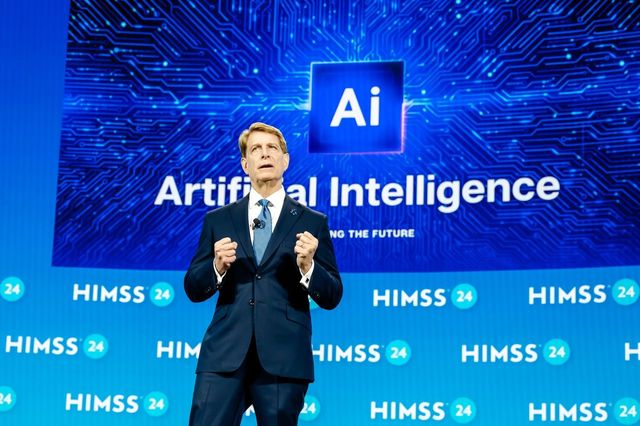During a keynote address this week at the HIMSS conference in Orlando, Hackensack Meridian Health CEO Robert Garrett declared that AI “has the potential to build healthier communities on a scale and pace that was previously unimaginable.”
As various industry sectors across the globe continue to deploy AI at rapid rate, Garrett said that healthcare leaders should take care to ensure their AI efforts seek to address one if not all of the following four priorities.
Increasing access to care
One out of four people don’t have a primary care physician — and for those under age 30, it’s one out of two, Garrett pointed out.
This statistic illustrates that healthcare organizations are failing to provide care for communities at scale, and this problem has the potential to get a lot worse. The number of people older than age 60 globally will soon double, creating an “unprecedented demand for care,” Garrett noted. When that happens, there will likely also still be a massive dearth of healthcare workers, he said.
This challenge is already motivating many of the healthcare AI projects around the world, Garrett remarked.

The Role of Consultants in Tackling Healthcare Expenses
To ensure effective cost mitigation, employers can’t wait for the market to adjust — they have to punch first.
For example, Indian digital healthcare platform Apollo 24|7 partnered with Google Cloud in January to provide AI-powered telemedicine to expand access to care throughout the country, he explained.
And at his own health system, algorithms are being deployed across various clinical departments to speed up mundane processes for clinicians and bring joy back into their work, Garrett noted.
Many algorithms not only save clinicians time, but also elevate the quality of care they provide. For instance, Garrett highlighted AI solutions that help radiologists prioritize the review of critical cases.
“This can be a true game changer, considering that a radiologist reviews up to 200 images each and every day,” he stated.
Improving patient outcomes
Garrett praised AI’s potential to quickly predict the onset of disease, accelerate the development of new therapies, create pathways for more personalized treatment and make healthcare more affordable.
He shone a spotlight on Grifols, a Spanish company specializing in plasma-based medicine, and its recent partnership with Google Cloud. The companies are using AI to discover how plasma can be used to develop new drugs that target fatal diseases.
Garrett also mentioned that Hackensack Meridian has been using an AI tool made by Carenostics to help physicians detect advanced kidney disease sooner.
“This could help delay dialysis treatment and even the need for transplant — amazing. This pilot also has the potential to advance health equity. Sadly, Black Americans are three times more likely than White Americans to suffer kidney failure,” he explained.
Hackensack Meridian is also using AI tools for scheduling optimization to ensure patients aren’t delaying care, he added. Delayed or deferred care often leads to adverse patient outcomes and episodes of care that are more costly and/or complicated than they could have been if the patient received timely, consistent care.
Advancing health equity
When it comes to improving health equity, healthcare leaders need to do a better job of paying attention to social determinants of health, Garrett declared.
“We also know that social factors like safe housing and good nutrition impacts people’s health much more than medical treatment,” he stated.
Healthcare organizations need to not only use AI to identify who is at risk for things like food and housing insecurity, but also to link these people to the resources they need, Garrett remarked.
He brought up an app developed at Phoenix Children’s Hospital. It uses AI to identify signs of malnutrition in pediatric patients, with nutritionists then verifying these findings and then connecting patients to nutrition treatment. Garrett said that the app identifies seven children per week who don’t have enough to eat.
“Imagine scaling that innovation to help millions of our children” he said.
Addressing climate change
In Garrett’s view, there is “no doubt” that AI can help identify major climate change events in the future.
“Between the years 2030 and 2050, climate change is expected to cause an additional 250,000 deaths per year from conditions like asthma and malnutrition and malaria. And one in four people are now living under drought conditions around the world,” he stated.
He reminded the audience that AI developers need to work on more solutions that help improve their energy efficiency, limit pollutants and create more renewable sources.
Photos: HIMSS









